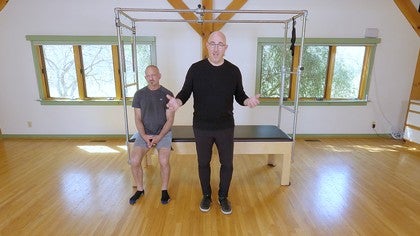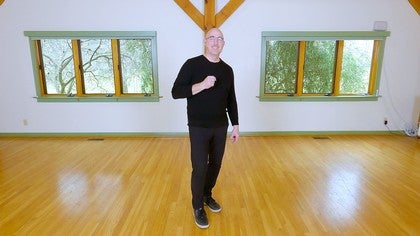Description
About This Video
Transcript
Read Full Transcript
So we've chosen our surgery, we've agreed to move forward with a surgeon, we've talked about pain and pain management. It's time to get ready for surgery. And in this section part three, we're looking at what do we need to do pre-surgery, and as a physical therapist and a Pilates teacher, there's some very specific things that we can work on as it pertains to therapeutic exercise. Three main points that I want to address, one is mobility, two is power, and three is function. When we think of mobility, they're already limited, we're already limited if we're the ones having the surgery due to the pain and the degeneration in the knee, but it's very important that we push ourselves to maintain as much range as possible.
And the reason being is that the more range we obtain, even if it's painful range in the soft tissues around the knee, the easier the recovery is after the surgery. That's a very important point. And sometimes it requires a more skilled practitioner therapist to get in there and sometimes push 'em into more uncomfortable positions. But the idea is that the more the soft tissue moves, the easier it is for us when it comes time to rehabilitate after surgery. The other areas that we wanna make sure are mobile, especially are gonna be the hip and the ankle because they're gonna be taking on a lot of the work in that first couple months coming out of the out of the postsurgical stage.
And we can do that with things that we've already shown for the ankle dorsiflexion, hip mobility, internal, external rotation, the more mobility we have in peripheral and proximal joints to the knee, the faster the rehabilitation will be. The second is power. We've talked about having the power, particularly in the hips. I can't emphasize enough being able to do things like we talked about with the Tai Chi movements and deceleration strengthening of the glutes, the rotators and the abductors of the hip to make sure that they can move quickly into the rehabilitation. If these muscles are weak, it's gonna be very hard to maintain dynamic alignment in the knees as they start walking.
I've told a story before of a patient who came to us, who was sent just for this pre-surgery consultation and strengthening before having both knees replaced. And as I was doing her history, I realized that she had had both of her hips replaced five years earlier. So when I started looking at her and how she was doing, what we realized is that she had never had rehabilitation, she had never strengthened up her hips. And we went in and we started training her hips and her strengthening, guess what happened to her knee pain? It disappeared and she no longer needed to have knee replacements.
Her knee pain was a result of poor rehabilitation of the hips. So do take the time and make the emphasis to reeducate the strength and the power of the hip, external rotators abductors and the glute hip extensors, really important. And the last one is function. I cannot emphasize function enough, function, function, function. The ability to get in and out of the shower, the ability to get on and off a toilet, the ability to step over the bathtub rim, all of those things are incredibly daunting to somebody who just had their knee replaced or their hip replaced.
So these are very important trainings that could happen before the surgery, rather than waiting till after the surgery. And the reason why I say that is that usually when we get this training, you know, we do this training as physical therapists is in the hospital. So you just had your surgery, you're on some kind of strong medication, and in that first afternoon, the physical therapist is making sure that you walk, making sure that you can get in out of bed, teaching you how to get on and off the toilet, and anything else that you might need to do at that early stage. The problem is you're probably not gonna remember it because you're pretty high from the medication, right? And unless you have a family member there, which hopefully you do, it's hard to remember those things.
So I prefer, and I have a lot of physicians that prefer this is that we educate them on these things prior. How do you put socks on the foot of the knee that just got replaced? How do you get dressed? What are some tips and things that they can practice before the surgery so it's more natural and easier for them after the surgery and less daunting? So these are some very important points.
I wanted to give some examples of what kind of movement expectations we have when we're working with our clients in the pre rehabilitation stage or the pre-training stage. So things that I use and I love using the Pilates equipment always, it's sort of my go-to tool, when I look at mobility, I think of things like just something as simple as footwork, feet and straps and maybe some standing leg pumps on the chair are some very fundamental exercises to maintain that range of motion. I talked about in the knee, in the hip and in the ankles, particularly in this sagittal plane, because we are dealing with the knee and the knee primarily moves in the sagittal plane. I also like the idea of feet and straps and being able to really get the hips mobile, doing hip circles, walking on the ceiling, any of those exercises that can really free up the hips. When we move in some examples of power, I think of things like, again, standing leg pump on the chair.
So just being able to get that hip nice and strong, but we can also do it from all angles, right? We can do it from sideways, diagonal, and sagittal(sagittal) to be able to make sure that we are strengthening those muscles and feel free to change the springs, change the height, change the surface that they're standing on to really challenge that power pre-surgery. They're gonna have, it's gonna be daunting to them to have the Walker and trying to go up and down stairs that first week. And so the more they're used to having that power in their hips to do it, they can rely on that, much easier for them. From the functional standpoint, things that I do in particular, sit to stand.
So I vary the height of the sit to stand from a low stool to a high table that might represent what their bed height is, what a wheelchair height might be and what the commode height is. Sometimes toilet seats are high in home, sometimes they're low. I always ask them ahead of time, how high is your toilet seat? Do I need to work with you on a height that is 18 inches off the ground, or do you have a 22 inch high toilet? And those three or four inches can make a huge difference in the independence that they have of getting down and off the toilet.
Also teaching them proper techniques, and they'll learn this in the hospital, but proper techniques of how to shift their weight to be able to stand up and how to use their assistive devices in particular safely so that they're not pulling on them or putting themselves at risk. Other things, find out, do they have a bathtub to go in and take their bath or shower or do they have a shower that they have to step over? How do they step over that bathtub rim or that shower rim to be able to get in safely? How do they avoid slipping? What kind of things can they do ahead of time to prevent these disasters that have happened in the past?
The last thing you want to do is spend 1000s of dollars on a surgery and all the anticipation of having a new knee and then to damage that new knee the first week from a slip and fall in your shower, your bathroom. Those are the kind of things would be a disaster. The only thing worse than that is an infection, that's why I remember, I reminded you, make sure that you're having your surgery in a very respectable hospital and OR. We also look at things like getting in and out of vehicles. So the patient has to be able to get into the vehicle, that's one of the toughest things, especially as a passenger, depending which knee.
So if it's my right knee and I'm getting in the passenger seat on the side, there's gonna be a torque on that knee if I don't learn how to do it correctly. So the way that I teach it is I just have them turn sideways into the car with their walker, sit their bottom back in the car and then bring their knees over inside, rather than thinking they're gonna twist their knee to get inside the car, the vehicle. It's also important that they might use a vehicle that's a little taller for that initial transport than something really low to the ground. So as cool as you might look in a Corvette or a Ferrari, much more sense to be in an SUV or something that's a higher height that we can use our arms to pull ourselves up into safely and comfortably. Other things that I think of is like picking things up off the floor.
Ahead of time, maybe encourage them to get those picker-upper, grabber things that are extensions, make a big difference in that first couple weeks when they drop a sock or drop something on the ground, they can reach down and pick it up and just some real practical advice on function, function, function. The better prepared they are in the beginning, the less likely they are to have problems that first week after surgery. And that's really the toughest time is that first week. And so these are good little tips. The last point that I have on here is mindset.
So what are we running through our mind? And one of the biggest challenges that we find and I find as a physical therapist with my patients going through this is fear. So they hear lots of stories, oh yeah, my knees are feeling much better, but the first week or the first month or the first three months was horrible, it was amazing. so much pain, I never had so much pain in my life. I didn't know whose knee it was and they hear these stories and they run these stories in their head.
And the problem with that is we start creating the anticipation that this surgery is gonna be very painful. And yet the new techniques and the new surgeries and the new pharmacological cocktails that they're using in surgery are getting so good that the amount of pain that people are experiencing today compared to even five, 10 years ago is significantly different. So we could say the total need of grandpa is not the same as the total need today, right? And I think that's really important to start changing the mindset. Yes, there's gonna be pain, it's not tissue damage, it's normal, the body is going through a healing process.
We're gonna manage that pain. We also want to respect the pain, we want to be able to embrace the pain. Yeah, there's pain, but when you're doing your exercises and your movement when you come home after surgery, that pain is not representing tissue damage. I'm gonna repeat that, the pain you feel when you're coming after surgery is not representing acute tissue damage, the tissue damage is already done, the repair is done. There no longer is cartilage damage because it's all gone.
So the pain that we're feeling now is the soft tissue pain around the knee from the surgery itself. And that takes a couple weeks to calm down if everything went really well. And so we wanna just respect it, anticipate it, calm it down in our mind, know that it's gonna get better, know that you're going to have a much higher function after surgery. Every time I talk to anybody that's been through a total joint, or I think of myself going through a total hip, it's like, there is this incredible relief by the time you get to the third, fourth month of where you realize, oh my goodness, I can do almost everything so much better than how I was feeling for the last 10, 15 years with a pain I was experiencing from that degenerated joint. So if you are really a candidate for surgery, look forward to the how good you're gonna feel, feeling a couple months out and how much better it's gonna be for us.
And the most common thing I hear from people who have successful knee replacements is, why didn't I do this earlier? Right? So the key thing here, take home message before surgery, do I really need surgery? We rule that out. If you do really need surgery, we pick our physician, we pick our technique, we pick how we want to go forward, we prepare our bodies with the movement expectations of post-surgery, we set our mind, we're gonna be better, we're gonna feel better, we're gonna be able to return to our activities, and we move forward confidence with the team that we picked.
I hope this helps in ways that you can prepare your clients or if you are the client, how you can prepare your own mindset and your body getting ready for surgery.
Knee Health: The Injured Knee and its Recovery
Comments
You need to be a subscriber to post a comment.
Please Log In or Create an Account to start your free trial.









